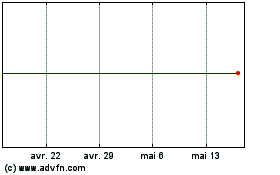SpaceX Seeks to Return Falcon 9 to Service in November
14 Septembre 2016 - 7:40AM
Dow Jones News
LONG BEACH, Calif.—Space Exploration Technologies Corp. on
Tuesday said it aims to resume Falcon 9 launches as early as
November from an alternate pad, after a rocket explosion during
ground tests two weeks ago caused what the Air Force calls moderate
damage to its launch site.
Senior Air Force and NASA officials, who addressed the issue
while attending a space conference here, didn't elaborate on the
specific damage to the pad and declined to predict when flights
might start up again, emphasizing that SpaceX, as billionaire
entrepreneur Elon Musk's company is known, is heading up the
investigation. Some industry officials have said the halt in Falcon
9 missions could stretch into early next year.
Hours earlier, however, at a satellite-industry conference in
Paris, Gwynne Shotwell, SpaceX's president and chief operating
officer, indicated the company was aiming to resume Falcon 9
flights in "the November time frame."
But given the significant repairs required to launch complex 40
at Florida's Cape Canaveral Air Force Station—along with the
government signoffs that will be needed—the company has decided it
will shift to a nearby NASA pad for its next East Coast launch.
Before the accident, which destroyed the booster and a
commercial satellite that was on board, SpaceX already was in the
process of modifying pad 39A at the National Aeronautics and Space
Administration's Kennedy Space Center to serve as a second Florida
launch location. The work remains on track to be completed sometime
in November, according to company and NASA officials.
SpaceX also is finishing up work to prepare a launchpad at
California's Vandenberg Air Force Base, which it also plans to use
for Falcon 9 operations. Ms. Shotwell didn't indicate whether the
next launch would be from Florida or California.
But in a brief interview on the sidelines of the conference,
NASA chief Charles Bolden said the Florida pad seemed most likely.
He said Mr. Musk has indicated "the next launch vehicle will be
shipped to" the Florida pad. "They were planning to do this
anyway," he said, because SpaceX needs both pads functioning in the
future "to be able to maintain the [launch] rate that they planned
in their business model."
Since SpaceX uses the Falcon 9 to send cargo to the
international space station, the final decision about the location
of the next launch may depend, in part, on SpaceX balancing the
agency's need for supplies in orbit with concerns of various
commercial customers jittery about getting their satellites
launched.
The cause of the rocket explosion hasn't been determined, though
Mr. Musk in a Twitter post described the SpaceX-led probe as the
"most difficult and complex failure" in the company's 14-year
history. Investigators are still trying to dissect whether the root
cause of the accident was a problem with part of the rocket, the
ground-based fueling system or a combination of factors.
During a media roundtable at the Long Beach conference, Winston
Beauchamp, deputy undersecretary of the Air Force for space, said
"the damage looks like it's moderate" and "definitely repairable."
But he added: "I don't have a time estimate yet" on how long that
effort will take.
In addition to setting back SpaceX's hopes of stepping up its
launch tempo to work through its growing backlog of delayed
launches, the accident also has disrupted plans that targeted the
initial flight of the company's heavy-lift booster, called the
Falcon Heavy, by the end of the year. Now, that demonstration
flight, a long-awaited milestone that is already years late, has
slipped to the first quarter of 2017, according to one person
familiar with the details.
Lars Hoffman, SpaceX's senior director of government sales, told
the Long Beach conference that "it's too early to tell" what
longer-term impact the accident may have on the Falcon Heavy's
flight schedule. "We are continuing preparations" for introducing
the beefed-up booster, including ramping up production and making
other moves across the company, he said. And fallout from the
accident "hasn't slowed anything at this point," Mr. Hoffman
said.
Write to Andy Pasztor at andy.pasztor@wsj.com
(END) Dow Jones Newswires
September 14, 2016 01:25 ET (05:25 GMT)
Copyright (c) 2016 Dow Jones & Company, Inc.
Twitter (NYSE:TWTR)
Graphique Historique de l'Action
De Juin 2024 à Juil 2024

Twitter (NYSE:TWTR)
Graphique Historique de l'Action
De Juil 2023 à Juil 2024
